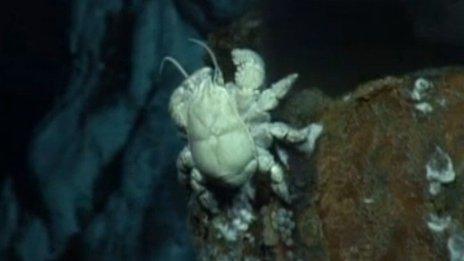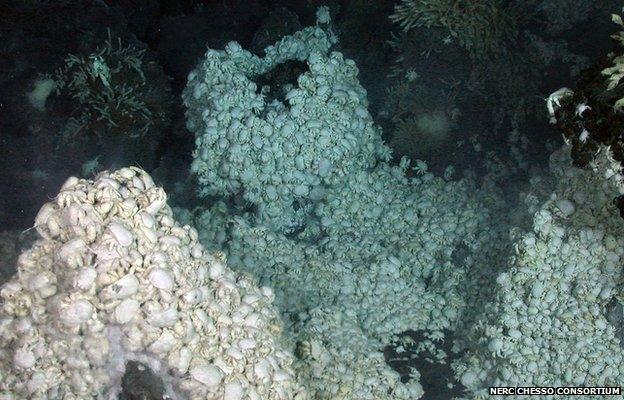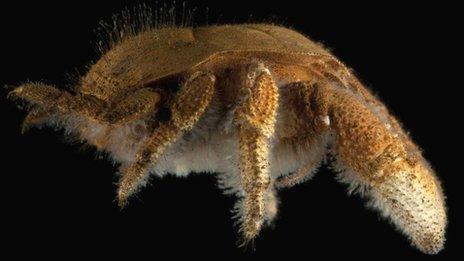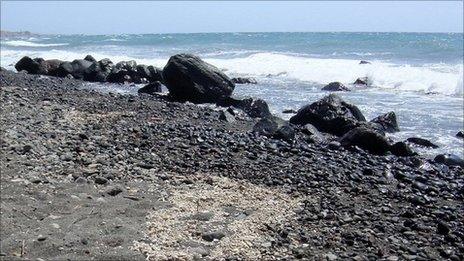'Hoff' yeti crab hitched ride on ocean super-highway
- Published

The crab was named after the frequently bare-chested actor David Hasselhoff
A hairy crab named after David Hasselhoff hitched a ride on an ocean "super-highway" to cross from the Pacific to the Atlantic millions of years ago.
The crabs reproduce by releasing many larvae into the water so that a handful reach other vents and colonise them.
But it is thought that they survive for only a short time in open waters; so a strong west-to-east current around Antarctica may have aided their spread.
The animal was discovered in 2011.
The "Hoff" is a type of yeti crab, which is recognised for its hairs, or setae, along its claws and limbs. It lives in one of the most extreme environments on the planet; more than 2,000m under the sea where volcanic vents superheat the water to 380C and there is no light and very little oxygen.
The crab feeds by "farming" bacteria on its hairy chest, then using special comb-like mouthparts to strain off the microbes so that it can eat them.
The crustacean's humorous nickname honours the hairy-chested US actor and singer David Hasselhoff.
In a study published in the journal, external Proceedings of the Royal Society B, Dr Christopher Roterman and colleagues propose that the "Hoff crab" probably originated around the vents that populate mid-ocean ridges in the eastern Pacific Ocean.
It then expanded into the Atlantic through the Drake Passage that separates South America and Antarctica, spreading along volcanic vent regions that are now extinct.
The crab appears to have exploited the ocean current known as the Antarctic Circumpolar Current (ACC), which flows in a clockwise direction, west to east around Antarctica, through Drake Passage.
The crabs can occur at astonishing densities around vents in the southern part of their range. But at the volcanic vents of the south-west Indian ridge, for example, the crabs only occur at low densities and are swamped by other vent animals.
Hoff crabs filmed around volcanic vents on the Southern Ocean floor
Dr Roterman, a zoologist at the University of Oxford, said the exact reasons for this were unclear, but it could have something to do with the crab's reproductive strategy.
"We suspect their [larvae] dispersal capability may be limited," he told BBC News.
"The fact they have spread so quickly in the Southern Ocean is because the ACC provides a high-speed highway for their larvae.
"But when they head further north, we think they may have a disadvantage against other hydrothermal vent animals."
This part of the research is only at a preliminary stage, said Dr Roterman, but examinations of the crab's larvae reveal they resemble miniature versions of the adult animal. However, these lack a functional mouth and have a small yolk sac. This suggests they may only be able to survive for short times in the water.
Analysis of the DNA of yeti crabs - including the Hoff variety - suggests these crustaceans began to expand and diversify about 40 million years ago.
Some scientists had wondered whether the animals living around volcanic vents were relic species, largely unaffected by environmental changes on land and shallower parts of the ocean.
But most of the species living around volcanic vents today appear to have radiated within the last 55 million years.
The reasons for this are unclear, but a period of intense global warming spanning several million years that dramatically reduced deep-sea oxygen levels globally could be to blame.

The crab occurs in staggering densities - up to 600 individuals per square metre
This event is known as the Palaeocene-Eocene thermal maximum and is marked by a rise in global temperatures of 6C. The causes remain unclear but the initial changes could have been amplified by a massive release into the atmosphere of methane stored in icy deposits on the ocean floor.
The latest paper appears to confirm a picture in which the inhabitants of deep-sea vents may be periodically wiped out and the vents only repopulated by a wave of new species once conditions become favourable again.
During episodes of extreme climate warming, circulation between the well oxygenated surface waters and those deeper down is thought to decline, leading to the gradual depletion of oxygen in the deep sea.
"Yeti crabs and other such creatures may in fact be especially prone to extinction when there is less oxygen available in the deep ocean," said Dr Roterman.
"This is because if deep-sea ocean oxygen levels fall, the amount of oxygen available to these animals, that already live in an oxygen-poor environment at the limits of their physiological tolerance, may drop below the minimum level at which they can survive.
"They would face the stark choice of 'suffocate or starve'."
Paul.Rincon-INTERNET@bbc.co.uk and follow me on Twitter, external
- Published4 January 2012

- Published28 December 2011

- Published2 September 2011
